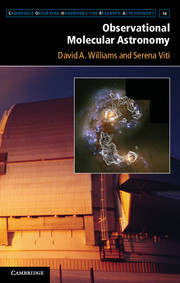Book contents
- Frontmatter
- Contents
- List of Illustrations
- List of Tables
- Preface
- 1 Introduction
- 2 Spectra and Excitation of Interstellar Molecules
- 3 Astrochemical Processes
- 4 Physical Processes in Different Astronomical Environments
- 5 Molecular Tracers in the Milky Way Galaxy
- 6 Molecular Tracers in External Galaxies
- 7 The Early Universe and the First Galaxies
- 8 Recipes for Molecular Submillimetre Astronomy
- 9 Chemical and Radiative Transfer Models
- 10 Observations: Which Molecule, Which Transition?
- Appendix: Acronyms
- Index
- References
4 - Physical Processes in Different Astronomical Environments
Published online by Cambridge University Press: 05 December 2013
- Frontmatter
- Contents
- List of Illustrations
- List of Tables
- Preface
- 1 Introduction
- 2 Spectra and Excitation of Interstellar Molecules
- 3 Astrochemical Processes
- 4 Physical Processes in Different Astronomical Environments
- 5 Molecular Tracers in the Milky Way Galaxy
- 6 Molecular Tracers in External Galaxies
- 7 The Early Universe and the First Galaxies
- 8 Recipes for Molecular Submillimetre Astronomy
- 9 Chemical and Radiative Transfer Models
- 10 Observations: Which Molecule, Which Transition?
- Appendix: Acronyms
- Index
- References
Summary
In Chapter 3 we saw that the chemistry producing molecular tracers in interstellar space is driven in a variety of ways: by electromagnetic radiation at UV and X-ray wavelengths; by ionisation caused by cosmic ray particles; by reactions on grains or in their icy mantles; and in chemistry induced by gas dynamics. In many types of region, some or all of these processes may act together; in others, one of them may dominate. The atomic and molecular tracers produced reflect the nature of the chemical drivers that are operating.
However, there is another complication. Each chemical driver does not always operate at the same rate; a driver may vary from place to place in the interstellar medium of a galaxy, or from galaxy to galaxy, or even from time to time. For example, the local UV radiation field in a galaxy with a transient high star-formation rate may be much more intense than the value corresponding to the mean intensity in the Milky Way Galaxy. Similarly, cosmic rays are accelerated by magnetohydrodynamical events and so locations of high dynamical activity may have much greater fluxes of cosmic rays than in more quiescent regions. Also, chemistry on dust grains is obviously affected by the dust:gas ratio and by the nature of the surfaces of the dust; both of these may vary from place to place within the Milky Way Galaxy, and from galaxy to galaxy. Finally, gas dynamical events causing shocks or turbulent mixing can be an important driver of the chemistry.
- Type
- Chapter
- Information
- Observational Molecular AstronomyExploring the Universe Using Molecular Line Emissions, pp. 50 - 61Publisher: Cambridge University PressPrint publication year: 2013

